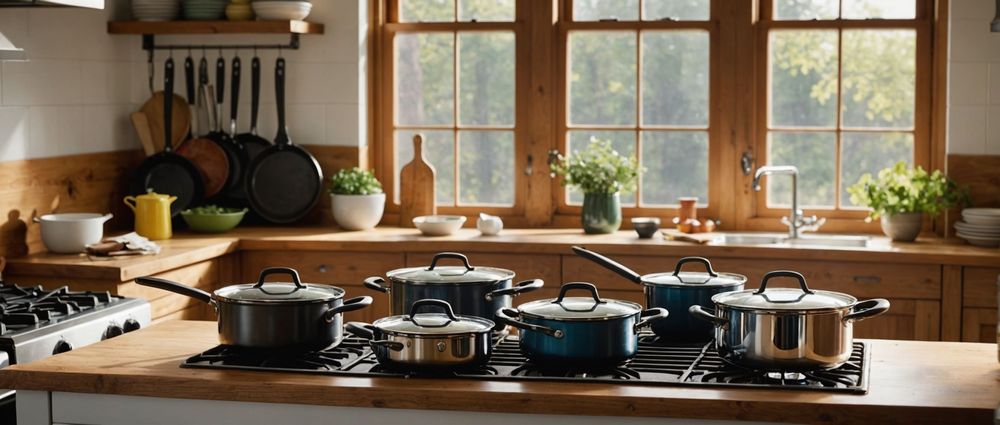Cooking disasters happen to the best of us, resulting in the unpleasant aftermath of burnt foods adhering stubbornly to our beloved cookware. Whether it’s a pot of rice that’s turned into a charred mosaic or a skillet with a layer of carbonized vegetables, burnt pots seem to be a rite of passage in every cook’s life. Yet, fear not. Even when traditional scrubbing does not yield results, several proven methods exist that will help rejuvenate your pans. This guide will offer you a comprehensive strategy for tackling those blackened burnt areas with ingredients that are likely already in your kitchen, so that tackling burnt residues becomes less of a challenge and more of an easy clean-up routine.
Introduction to the Challenge of Burnt Pans
Accepting the challenge of removing stains from burnt cookware is the first step towards redemption for your pots and pans. Recognize that burnt residues are often a mixture of sugars, fats, and proteins that have polymerized under intense heat, creating a surface that will not relent easily. The key is patience and understanding that some methods might not work immediately but can help change the situation with persistent effort.
Understanding the Nature of Burnt Food Residue
The chemistry behind burnt food is as complex as the palate of flavors it once offered. When food residues experience high heat, they undergo a series of reactions that leave behind a carbonized layer that might appear inseparable from the pan. But with the right approach, you can help transform the pot’s surface back to its original sheen.
Pre-cleaning Steps before Tackling Burnt Food
Safety and Preparation
To eliminates risks, ensure your cookware has cooled down. Hot surfaces and impromptu cleaning attempts may lead to thermal injuries. Once cooled, removing loose debris can help expose the actual burnt on area. Safety gloves are recommended when dealing with chemical ingredients or rigorous scrubbing.
Removing Loose Debris
Attempt to discard any loose burnt bits that aren’t fused to the pan. This can be done with a dry paper towel or a wooden spatula, taking care not to scratch the surface. By doing this, you’re creating a clearer battlefield where the primary focus will be on the truly resistant burnt areas.

Effective Methods to Remove Burnt Food from Pans
The Boiling Water Technique
- Fill the pan with water until the burnt residues are submerged.
- Bring the water to a boil and let it simmer for several minutes.
This can help loosen the hardened layers, making them easier to scrub off. Adding one spoonful of dishwashing soap into the boiling mixture may boost the cleaning power.
Step-by-Step Process
| Steps | Description |
|---|---|
| 1 | Fill the burnt pot with water, covering the burnt bits. |
| 2 | Add dish soap to the water for extra cleaning efficacy. |
| 3 | Heat until boiling, then reduce to a simmer. |
| 4 | Allow the solution to work on the burnt areas for 10-15 minutes. |
| 5 | Remove from heat then rinse with warm water. |
| 6 | If residue persists, proceed to the next recommended step. |
After removing the pan from the heat, use a spatula or wooden spoon to gently scrape away the lifted food residues. Caution should be taken to not use metal utensils on non-stick or stainless steel surfaces, to avoid additional scratches.
The Baking Soda Method
Baking soda is a mild abrasive and helps remove lingering stains without causing harm to most surfaces. Sprinkle a generous amount of baking soda over the burnt residues and then add water to create a paste. Allow this mixture to sit for several hours, or overnight, if the pan’s condition is severe.
How to Use Baking Soda for Stubborn Stains
When using baking soda, the technique often requires the addition of elbow grease. After letting the paste sit, scrub the pan using a non-metallic brush or sponge. For more stubborn areas, a second application of baking soda might be necessary. Once you’ve finished scrubbing, then rinse the pan thoroughly.
Utilizing Vinegar – Nature’s Cleaner
Vinegar’s acidity is ideal for breaking down burnt food deposits. Make a mixture of equal parts water and vinegar and bring it to a simmer in the pan. This non-toxic method not only does not produce harmful fumes but also will all but guarantee a more pleasant cleaning process.
Instructions for the Vinegar Solution
The simmering vinegar solution should be given enough time to permeate the burnt residues but should not be left unattended. After simmering for a few minutes, turn off the heat and let the pan cool. Once it’s safe to touch, use a scrubbing pad to work away at the loosened grime.
The Power of Salt Scrubs
Coarse salt holds the ability to scour away burnt food without damaging the underlying surface of most pans like stainless steel ones. Sprinkle a liberal amount of salt onto the burnt areas, then add a little water to form a gritty paste. Adding one lemon’s juice to the mixture can boost acidity, which aids in breaking down the residue.
Salt-based Cleaning in Action
Use a sponge or scrubbing brush to work the salt into the burnt residues. The abrasive nature of the salt helps remove the food particles, and the lemon juice acts as a natural degreaser, which can be particularly helpful if the burnt food was oily or fatty.

Alternative Methods and Tips for Burnt Pan Rescue
The Role of Fabric Softener Sheets
In a surprising turn of household hacks, using a fabric softener sheet can aid in releasing burnt residues. Fill the pan with warm water, place a fabric softener sheet within, and allow it to soak overnight. The conditioning agents in the sheet will alleviate the bond between the food and the pan, making it easier to clean the following day.
Aluminum Foil as a Scrubbing Agent
If you don’t have a scrubbing brush on hand, aluminum foil can serve as an effective alternative. Crumple a piece of foil into a ball and use it to scrub the pan with the assistance of your chosen cleaning solution. This method should be used with caution, as it might not be suitable for all types of cookware, especially non-stick surfaces.
Preventative Measures for the Future
Good Cooking Practices to Avoid Food Burn
Prevention is the best remedy. Some key practices include stirring food regularly, utilizing appropriate heat settings, and never leaving cooking food unattended for extended periods. Cooking with liquids helps prevent food from sticking, and oils should be heated up with the pan to create a natural barrier.
Proper Pan Maintenance Tips
After each use, cleaning your pan thoroughly will help maintain its quality. Avoid using metal utensils during cooking to prevent scratches that food can adhere to. If you’re cooking acidic foods or using high heat, then add high-smoke point oils to protect the pan’s surface.
Conclusion
Summarizing the Pan Cleaning Techniques
In conclusion, while burnt food on cookware is a common issue, several effective strategies can help remove it. Starting with simple household remedies like boiling water, baking soda, and vinegar, to using products like salt and commercial cleaners, there are solutions suitable for everyone’s comfort and safety levels.
Encouragement for Future Cooking Endeavors
Don’t let a burnt pan discourage you from your culinary experiments. With the proper knowledge and tools, any burnt cookware can be restored and ready for your next meal preparation. Maintain your cookware, experiment confidently, and know that even the most stubborn burnt areas have their cleaning match.

Frequently Asked Questions (FAQs)
Q: Is the cleaning process the same for all types of cookware?
A: While the methods are broadly applicable, the material of your cookware (e.g., stainless steel, cast iron, non-stick) might necessitate specific care. Always consider the manufacturer’s recommendations to prevent damage to the pan.
Q: How can I clean a non-stick pan without damaging the coating?
A: For non-stick pans, steer clear of abrasive scrubbers or harsh chemicals. Soaking in hot, soapy water often does the trick, with gentle wiping rather than scrubbing to preserve the non-stick surface.
Q: My pan is extremely burnt; is it salvageable?
A: Even severely burnt pans can often be saved. However, if the pan is warped, the non-stick coating is flaking, or if there are deep scratches, it may be time to consider a replacement for safety reasons.
Q: When should I decide to stop cleaning and just replace my pans?
A: Regular maintenance can greatly extend the life of your pans. However, once the performance is compromised, or if there are signs of rust or deterioration, it’s best to invest in new cookware.
Q: Is there a quick way to clean burnt pans if I’m in a hurry?
A: Unfortunately, there’s no instant miracle cure for burnt pans. However, soaking the pan in hot, soapy water or a vinegar solution can expedite the process. Be prepared to let the pan soak for at least an hour before attempting to clean.



